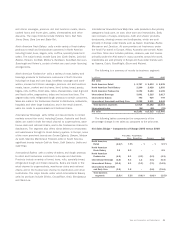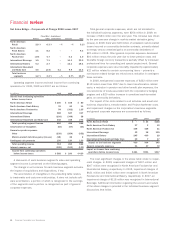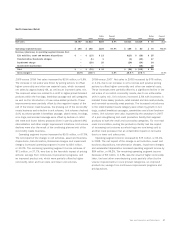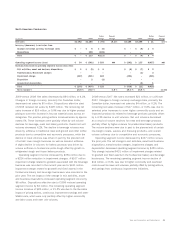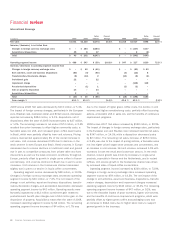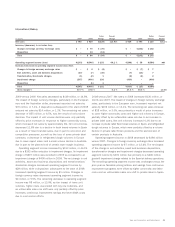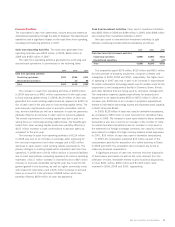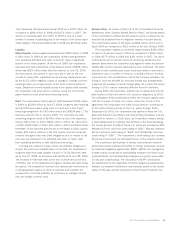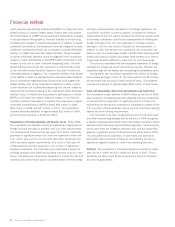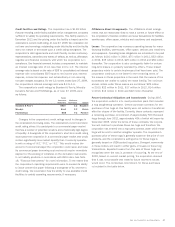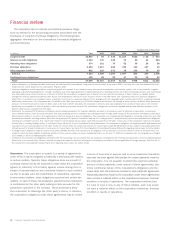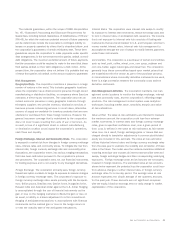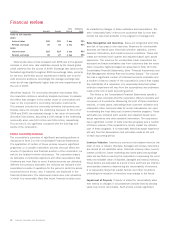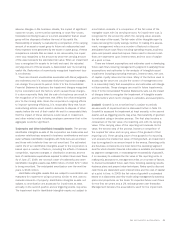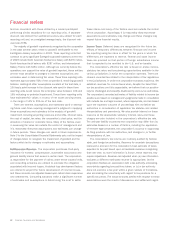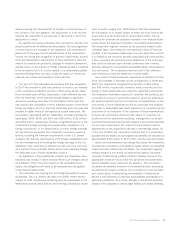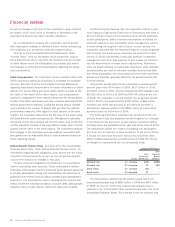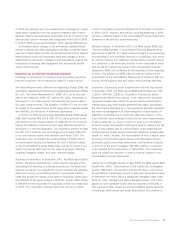Sara Lee 2009 Annual Report Download - page 37
Download and view the complete annual report
Please find page 37 of the 2009 Sara Lee annual report below. You can navigate through the pages in the report by either clicking on the pages listed below, or by using the keyword search tool below to find specific information within the annual report.Pension Plans As shown in Note 19 to the Consolidated Financial
Statements, titled “Defined Benefit Pension Plans,” the funded status
of the corporation’s defined benefit pension plans is defined as the
amount the projected benefit obligation exceeds the plan assets.
The underfunded status of the plans is $466 million at the end of
fiscal 2009 as compared to $321 million at the end of fiscal 2008.
The corporation expects to contribute approximately $180 million
of cash to its pension plans in 2010 as compared to $306 million
in 2009, $175 million in 2008 and $191 million in 2007. The 2010
contributions are for pension plans of continuing operations and
pension plans where the corporation has agreed to retain the pension
liability after certain business dispositions were completed. The exact
amount of cash contributions made to pension plans in any year is
dependent upon a number of factors, including minimum funding
requirements in the jurisdictions in which the company operates, the
timing of cash tax benefits for amounts funded and arrangements
made with the trustees of certain foreign plans. As a result, the actual
funding in 2010 may be materially different from the estimate.
During 2006, the corporation entered into an agreement with the
plan trustee to fully fund certain U.K. pension obligations by 2015.
The anticipated 2010 contributions reflect the amounts agreed upon
with the trustees of these U.K. plans. Under the terms of this
agreement, the corporation will make annual pension contributions
of 32 million British pounds to the U.K. plans through 2015.
Subsequent to 2015, the corporation has agreed to keep the U.K.
plans fully funded in accordance with local funding standards. If at any
time prior to January 1, 2016, Sara Lee Corporation ceases having
a credit rating equal to or greater than all three of the following ratings,
the annual pension funding of these U.K. plans will increase by 20%:
Standard & Poor’s minimum credit rating of “BBB-,” Moody’s Investors
Service minimum credit rating of “Baa3” and FitchRatings minimum
credit rating of “BBB -.” The corporation’s credit ratings are currently
above these levels and are discussed below in this Liquidity section.
The corporation participates in various multi-employer pension
plans that provide retirement benefits to certain employees covered
by collective bargaining agreements (MEPP). MEPPs are managed by
trustee boards comprised of participating employer and labor union
representatives, and participating employers are jointly responsible
for any plan underfunding. The corporation’s MEPP contributions
are established by the applicable collective bargaining agreements;
however, our required contributions may increase based on the funded
status of the plan and the provisions of the Pension Protection Act,
Sara Lee Corporation and Subsidiaries 35
Cash Dividends
Dividends paid during 2009 were $302 million as
compared to $296 million in 2008 and $374 million in 2007. The
decline in dividends paid from 2007 to 2009 is due to a lower
number of shares outstanding due to the impact of the share repur-
chase program. The annual dividend rate in 2009 was $0.44 per share.
Liquidity
Notes Payable Notes payable decreased from $280 million in 2008
to $20 million in 2009 as the corporation utilized cash generated
from operating activities and cash on hand to repay a significant
portion of the notes payable. At the end of 2009, the corporation
had cash and cash equivalents on the balance sheet of $959 million,
which was $325 million lower than the balance at June 28, 2008.
As noted above, the decline in cash was due in part to the use
of cash to repay debt, repurchase stock and pay dividends as well
as the $172 million negative impact of changes in foreign currency
exchange rates, as a large portion of the cash is denominated in
euros. Despite the recent liquidity issues in the global credit markets,
the corporation has been able to continue using the commercial
paper market to fund short-term borrowing needs.
Debt The corporation’s total long-term debt decreased $108 million
in 2009, to $2,800 million at June 27, 2009. Long-term debt maturing
during 2009 was repaid using cash on hand and a new 2-year
financing arrangement for 285 million euros at EURIBOR plus 1.75%
that was entered into in January 2009. The corporation’s total
remaining long-term debt of $2,800 million is due to be repaid as
follows: $55 million in 2010, $425 million in 2011, $1,164 million
in 2012, $528 million in 2013, $25 million in 2014 and $603 million
thereafter. Of the amounts that are due to be repaid in 2010, approx-
imately $25 million matures in the first quarter and the remainder
matures throughout the year. Debt obligations due to mature in the
next year are expected to be satisfied with cash on hand, cash
from operating activities or with additional borrowings.
Including the impact of swaps, which are effective hedges and
convert the economic characteristics of the debt, the corporation’s
long-term debt and notes payable consist of 70.3% fixed-rate debt
as of June 27, 2009, as compared with 66.2% as of June 28, 2008.
The increase in fixed-rate debt at the end of 2009 versus the end
of 2008 is due to the repayment of long-term variable rate debt during
the period. The corporation monitors the interest rate environments
in the geographic regions in which it operates and modifies the
components of its debt portfolio as necessary to manage interest
rate and foreign currency risks.


